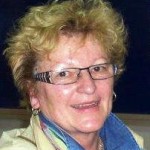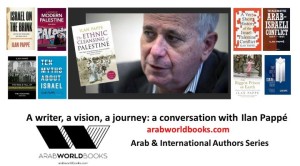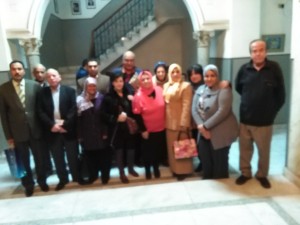This paper was prepared as a contribution to the 2nd International Conference on Creativity and Writing, Orivesi, Finland, 19 to 22 November, 2010.
As an Australian writer having lived most of my life in countries not of my mother tongue, I have employed various strategies to warm up before sitting down to write. These range from online writing groups and exercises, snail mail collaborations and mentoring to inter-face (face-to-face) workshops and conferences.
Ultimately, it is when the seat of one’s pants is on the chair, when the pen touches the paper, when the fingers hit the keyboard, that the writing gets done. Thomas Edison said that “Genius is one percent inspiration and ninety-nine percent perspiration” (http://en.wikiquote.org/wiki/Thomas_Edison). Let’s give creative writing a bit more leeway, say 95/5. And it’s that 5% of inspiration that I want to talk about, for we all know that the rest is hard work.
How to get inspiration? You don’t really need other people, but it does me good to be with like- minded ones engaged in the practice of writing, from time to time. And this can be online in a café or at home, or face-to-face at a conference or writing group. This paper is based on my experiences.
Although I present my experiences in chronological order, this does not mean to say that any order is necessary when trying out some of the ideas.
I will show how a workshop exercise on free writing led to a story that itself contained nothing from the words of the exercise but was driven by associations the exercise triggered. Other examples will be from a month-long online project in which daily stories of 300 words were written in response to 300-word messages posted by the project leader. I will also mention a five-day workshop on the senses that was run in a brothel in Vienna as a project of the Vienna Poetry Academy within the 2006 Wiener Festwochen – Into the City.
I will also share what I call golden “nuggets”, pieces of wisdom that have stayed with me long after workshops and conferences have finished, and I will mention the beneficial effects of “cross- pollination”, validating experiences unrelated to the practice of writing, and playing with genres. Drawing on correspondence courses with the Canadian writer, Timothy Findley and the Australian, Peter Carey, I will share some ideas that I found useful – “method writing” as if method acting (Findley) and cantilevering (Carey).
Also included are books I have found useful, as well as links to online places where one might find more examples of prompts and exercises.
Armed thus with insights and gems scribbled in notebooks, the sitting on the chair before the blank screen or page then in its own way can become inspirational.
1. Random words
In the pre-web days, I participated from 1992-1995 in Compuserve ́s Writers ́ Forum in the Section, Writing Exercises. We were given six random and unrelated words and told to write a story within one week. The words were: chartreuse, scales, sloth, sushi, thunder, timpani. These words led to my whimsical story, “Old Japan”, which was first published in Yomimono, Hiroshima, Japan, and led to a longer story, “An Imaginary Friend”, published in Thema, USA, and in my story collection, The Past Present. “An Imaginary Friend” has been translated into French by Geneviève Hébert as part of a Masters in Literary Translation.
Nugget: Use a series of six unrelated words to make a story. All words must appear.
2. Associations
From 1995 to 2005, I was a member of the Geneva Writers ́ Group. We had monthly workshops, a conference every two years and every other year we issued the literary journal, Offshoots – Writing in Geneva. At the time, I was speaking French at work and German at home and was very conscious of needing to reclaim my mother tongue and also of claiming the right to write – I had never studied English literature, I was speaking a trilingual “mish mash”, I didn’t know where I belonged, or indeed, whether I had to.
Under the guidance of Susan Tiberghien, we learnt how to give and take feedback and how to network – meeting likeminded people and sharing ideas and support. Susan introduced us to the freewriting exercises of Nathalie Goldberg using the latter’s book, Writing Down the Bones. One of the exercises was to write for ten minutes in response to: “The first thing I saw this morning was...”.
It was February in Geneva and the first thing I saw was a frozen droplet on the windscreen of my car. But in my hometown in Sydney, bushfires were raging and so the droplet became “a frozen tear”. The “frozen tear” triggered a story called “Fire Cries”, subsequently published in the US and in my first story collection, The Past Present (200/2001); “Fire Cries” morphed into “Bogey Man” which was published in The European (now defunct) and in my second collection, Back Burning (2007). No frozen tear appeared in either “Fire Cries” or “Bogey Man”.
Nugget: Using the phrases “First thing this morning I saw ...” or “I remember...” or even “I don’t remember...” write for ten minutes, not stopping to think, not worrying about grammar and punctuation. Then look at what you have written. Much will not be useful, but some images may jump out at you (like my “frozen tear” did). Now take that image and write a story. It doesn’t matter if you lose the image on the way. More often that not, the image is just a catalyst.
For freewriting exercises, see Nathalie Goldberg's Writing Down the Bones. (Review) and Susan Tiberghien ́s One Year to a Writing Life (Review)
3. Boot Camp and purple hearts
Online at the Compuserve Writers’ Forum, I met a Welsh writer, Alex Keegan, and followed him to participate from 1996 to 1999 in his online Boot Camp. We were a group of about eight from predominantly the US and the UK. It was a hard-hitting group as befits any boot camp, ruled by the mantra: read, read, read - write, write, write - submit, submit, submit. We learnt to analyse stories by Chekov, Carver, Munro and other well-known short-story writers, as well as stories from Best American Stories. We learnt to recognise what worked and what didn’t. We all committed to writing a story every two weeks and to critiquing the story of others by opening, plot, theme, character, voice, language, and ending. We were encouraged to KISS (keep it simple, stupid). We were encouraged to ask SFW? (So facking what?) What is the point of the story? Not what is it about, but what passion drives you to write it? Then we shared markets, submitted our work, collected rejections and celebrated our hits. Each week we would play with prompts to trigger stories. This was my MfA in Creative Writing. Almost 50 of my stories were written, and published online and in print, during this time.
Nugget: rejections are like purple hearts; rejections are part of the game; learn to read rejections; learn to read the market; be professional. KISS and ask SFW. Make a list of random words and phrases, choose one word or phrase that speaks to you and write a story.
4. Romancing the rhinestone
In 1997, I attend the Summer Workshop run by the Humber School for Writers at Humber College in Toronto, Canada, and worked for an intensive week with Wayson Choy, author of The Jade Peony. At this workshop we learnt how to revise our stories, how to pare things down and give setting to our images.
Nugget: Only have one wonderful metaphor per page, at the most: one perfect diamond stands out much more than a necklace of rhinestones.
5. Method writing
In 1999 through the Humber School for Writers, I participated in a 30-week correspondence course with Timothy Findley, author of Famous Last Words, Pilgrim and other novels. I was working on two novels that I discovered were in fact one. Findley had been an actor before he became a writer and had worked with, among others, Thornton Wilder. When writing The Wars, he tried to simulate what it could have been like in the trenches and then transferred his physical and emotional experiences to paper, transferring “method acting” to a sort of “method writing”. He taught me that the beginning of a novel might not always be where one thinks and that structure need not be linear when exploring the past. He suggested that diary entries, letters, newspaper clippings could all be useful in anchoring time. The structure of Famous Last Words is a good example of this.
Nugget: You might find your true beginning on page 200 of your novel. You can show the past in letters and diary entries, newspaper cuttings, memories; explore structure. Invest in your craft. Take an education loan if you must to pay for mentoring by the masters.
6. Cantilevering
In 2000, again through the Humber School for Writers, I participated in another 30-week correspondence course with Peter Carey. (My mother-in-law was kind enough to pay for the course as a birthday gift.) Over the whole 30 weeks we worked on the same 20 pages. I had to strip all my lovely words back to a minimum and find the essential points. Then I had to take each bit and zoom in with a maximum of detail, strip back again, add, strip back, etc. This was cantilevering. In terms of motivation it was a little like a one-step-forward-two-steps-back approach, but one worth pursuing for the combination of steps led to the story, “Mimosa”, in my collection Back Burning.
Nugget: Cantilevering: Start with 20 pages, strip back to the minimum. Take each bit and zoom in to the maximum, strip back to the essentials, add, strip back, add, strip back, etc. Enlist the help of family members to support – time- and moneywise - your passion for the craft.
7. Eros of the senses
In 2006 I moved to Vienna and participated in a workshop of the Vienna Poetry Academy, Orpheus in Eurydike. The workshop was led by the Austrian songwriter and novelist, Ernst Molden, and the German poet, Augusta Laar, and it was held in a brothel, or “House of the Rising Sun”. From 6pm to 9pm we had the run of the establishment and in five separate sessions were encouraged to focus on each of the senses: touch, taste, smell, sight and hearing. We chose our genre from prose, poetry or song lyrics. The sessions were conducted in German but I insisted on writing my story in English. An interesting discovery was that what I thought I had seen on the first day when everything was unaccustomed and I was vulnerable and self-protective was in fact not the reality I saw at the end. When I first arrived at the establishment located on a busy road it was broad daylight; everyone could see me waiting for the door to Dream Eros to open. When writing of my first impressions I wrote that the entrance was tiled with mirrors, and I was sure of this. I noticed, at the end of the workshop, that there were no mirrors at the front door, they were on the inside. We performed our work in another establishment, the Queen Club, to a full house during the May festival, Wiener Festwochen – Into the City. Subsequently, we presented our pieces in September during the literary 24-hour marathon, Rund um die Burg.
Nugget: Tell a story and concentrate on each of the senses separately; write the story several times. Then decide which sense needs to prevail, yet still introduce the other senses to a lesser extent. This can heighten an appreciation of the whole. Perhaps here, do some cantilevering.
8. A story a day
In 2007, I participated in Your Messages Online Writing Project with the short-story writer Sarah Salway and the poet, Lynne Rees. During the month of November we responded every day in exactly 300 words to a 300-word entry from the book, Messages, an exchange between the two writers. I had been following the work of a Finnish recycling designer, Outsapop, and so one of my “shorties”, “Trashion Passion”, became inspired by her and her work. “Trashion Passion” was included in the charity anthology, 50 Stories for Pakistan. Outsapop’s work inspired mine and, in return, she posted my story on her blog. Crosspollination?
Nugget: Write first thing every day. Prune to exactly 300 words. It’s a bit like squeezing your freewriting into a corset. Do this for a week, a month, a year and grow the seeds of stories. Several of what I gathered as Merc ́s Shorties have found a home just as they are or have led to longer stories.
9. Critical theory
From 2004 to 2009 I worked on my PhD in Creative Writing as a distance research student at UNSW, Sydney. The critical part of my dissertation dealt with smell and dislocation in the stories of the Australian expatriate writer, Janette Turner Hospital. Through my reading I not only discovered the link between memory and smell, but also stumbled on the idea of “belonging” as a “longing to be”. In retrospect, I think this idea underpins much of my work. The academic writing helped me in my quest for structure. Indeed, my nickname, Mercuryblobs was given to me by that Bootcamp sergeant, Alex Keegan. “You’re like a blob of mercury dropped on a lab floor. You’re all over the place. You have no structure.” I have learnt to embrace the blobs and am still trying to rein them in. But I cannot deny them.
Nugget: Reading critical theory and exploring new developments and research, together with a good dose of crosspollination can help distil the underlying meanings of our writing passion. Although academic and creative writing are very different, both types, to my mind, can learn from each other.
10. On the other side
In 2010 in Vienna, I ran a workshop on Flash Fiction at the Urania. I was able to draw on all my experiences as well as on the tips and guidance of a mistress of the art, Tania Hershman, a science writer of flash fiction and short stories who teaches and generously shares what she knows in her blog.
Nugget: Follow developments, read the work of your contemporaries writing in your chosen genre. Inspiration and support abounds. Embrace it.
I hope that my experiences have been able to inspire you in some small way. Pass them on, share them. I have to go now. I have to get writing.




